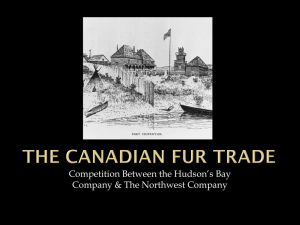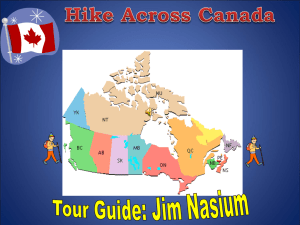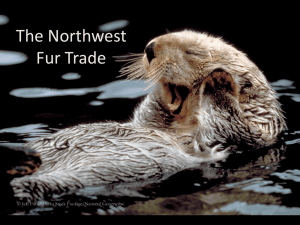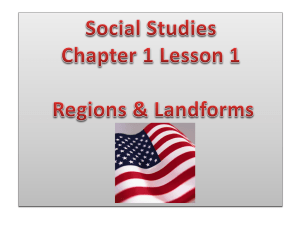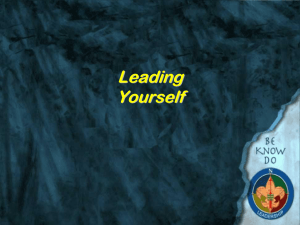Mountain men
advertisement
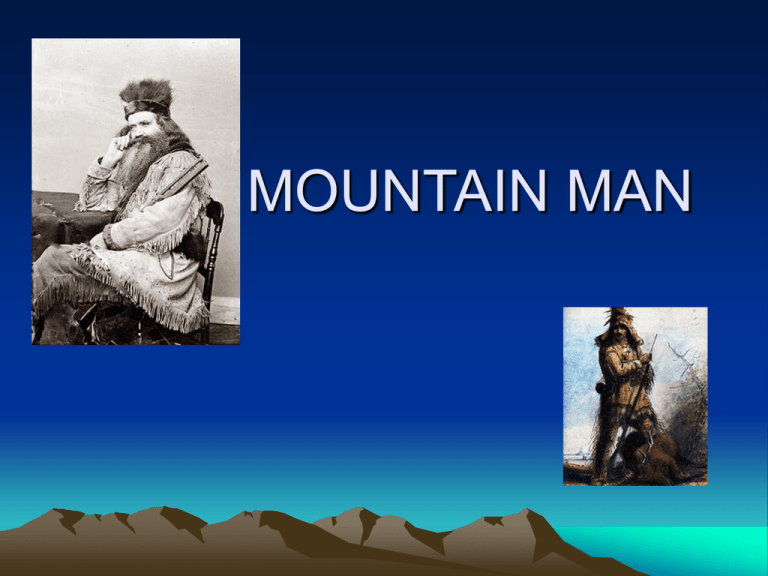
MOUNTAIN MAN mountain man • A trapper and explorer who lives in the wilderness. They were most common in the North American Rocky Mountains from about 1810 through the 1880s (with a peak population in the early 1840s). They were instrumental in opening up the various Emigrant Trails (widened into wagon roads) allowing Americans in the east to settle the new territories of the far west by organized wagon trains traveling over roads explored and in many cases, physically improved by the mountain men and the big fur companies originally to serve the mule train based inland fur trade. • They arose in a natural geographic and economic expansion driven by the lucrative earnings available in the North American Fur Trade, in the wake of the various 1806–07 published accounts of the Lewis and Clark Expedition • Approximately 3,000 mountain men ranged the mountains between 1820 and 1840, the peak beaver-harvesting period. While there were many free trappers, most mountain men were employed by major fur companies. The life of a company man was almost militarized. The men had mess groups, hunted and trapped in brigades and always reported to the head of the trapping party. • Donald Mackenzie, representing the North West Company, held a Rendezvous in the Boise River Valley in 1819. The rendezvous system was later implemented by William Henry Ashley of the Rocky Mountain Fur Company, whose company representatives would haul supplies to specific mountain locations in the spring, engage in trading with trappers, and bring pelts back to communities on the Missouri and Mississippi rivers in the fall. Ashley sold his business to the outfit of Jackson and Sublette. He continued to earn revenue by selling that firm their supplies. This system of rendezvous with trappers continued when other firms, particularly the American Fur Company owned by John Jacob Astor, entered the field. • The annual rendezvous was often held at Horse Creek on the Green River, near present-day Pinedale, Wyoming. By the mid-1830s, it attracted 450-500 men annually, essentially all the American trappers and traders working in the Rockies, as well as numerous Native Americans • In the late 1830s, the Canadian-based Hudson's Bay Company instituted a policy to destroy the American fur trade. The HBC's annual Snake River Expedition was transformed to a trading enterprise. Beginning in 1834, it visited the American Rendezvous to buy furs at low prices. The HBC was able to offer manufactured trade goods at prices far below that with which American fur companies could compete. • Combined with a decline in demand for and supply of beaver, by 1840 the HBC had effectively destroyed the American system. The last rendezvous was held in 1840. During the same years, fashion in Europe shifted away from the formerly popular beaver hats; at the same time, the animal had become overhunted. After achieving an American monopoly by 1830, Astor got out of the fur business before its decline • By 1841 the American Fur Company and the Rocky Mountain Fur Company were in ruins. By 1846 only some 50 American trappers still worked in the Snake River country, compared to 500-600 in 1826. Soon after the strategic victory by the HBC, the Snake River route was used for emigrants as the Oregon Trail, which brought a new form of competition. Former trappers earned money as guides or hunters for the emigrant parties • A second fur trading and supply center grew up in Taos in what is today New Mexico. This trade attracted numerous French Americans from Louisiana and some French Canadian trappers, in addition to AngloAmericans. Some New Mexican residents also pursued the beaver trade, as Mexican citizens initially had some legal advantages. Trappers and traders in the Southwest covered territory that was generally inaccessible to the large fur companies. It included parts of New Mexico, Nevada, California and central and southern Utah. After the decline in beaver and the fur trade, with some emigrants to the West using the Mormon Trail, former trappers found work as guides and hunters for the traveling parties • After the short-lived American Pacific Fur Company was sold, the British controlled the fur trade in the Pacific Northwest, under first the North West Company and then the Hudson's Bay Company. To prevent American fur traders from competing, the British companies adopted a policy of destroying fur resources west of the Rocky Mountains, especially in the upper Snake River country. After the Hudson's Bay Company took over operations in the Pacific Northwest in 1821, the Snake River country was rapidly trapped out. • This halted American expansion into the region. After 1825 few American trappers worked west of the Rocky Mountains, and those who did generally found it unprofitable. This policy of the Hudson's Bay Company forced American trappers to remain in the Rocky Mountains, which gave rise to the term "mountain men • The stereotypical mountain man has been depicted as dressed in buckskin and a coonskin cap, sporting bushy facial hair and carrying a Hawken rifle and Bowie knife, commonly referred to as a "scalpin' knife." They have been romanticized as honorable men with their own chivalrous code, loners who would help those in need but who had found their home in the wild • Most trappers traveled and worked in companies. Their typical dress combined woolen hats and cloaks with serviceable Indian-style leather breeches and shirts. Mountain men often wore moccasins, but generally carried a pair of heavy boots for rough terrain. Each mountain man also carried basic gear, which could include arms, powder horns and a shot pouch, knives and hatchets, canteens, cooking utensils, and supplies of tobacco, coffee, salt, and pemmican. Items (other than shooting supplies) that needed to be "at hand" were carried in a "possibles" bag. Horses or mules were essential, in sufficient number for a riding horse for each man and at least one for carrying supplies and furs • In summer, mountain men searched for fur animals, but they waited until autumn to set their traplines. They sometimes worked in groups. Several men would trap, others would hunt for game, and one would remain in camp to guard the camp and be a cook. Since there were always Indians in the areas where they trapped, trappers had to deal with each tribe or band separately. Some tribes were friendly, while others were hostile. Mountain men traded with friendly tribes and exchanged information. Hostile tribes were avoided when possible • The life of a mountain man was rugged. They explored unmapped areas. Bears and hostile tribes presented constant physical dangers. Mountain men had to use their senses of hearing, sight, and smell to keep themselves alive. When they were sick, they would use whatever herbs they had to try to get well. If game was scarce, they would go hungry. In summer they could catch fish, build a log cabin, and roam in search of fur. Cabins were built near friendly Indians. But in other areas, most camps were just temporary. Most winters were brutal. Heavy snow storms or extremely low temperatures keep men in their cabins. But no matter what the season, there was always danger. Many men did not last more than several years in the wilderness • With the exception of coffee, their food supplies generally duplicated the diet of native tribes in the areas where they trapped. Fresh red meat, fowl, and fish were generally available. Some plant foods, such as fruit and berries, were easy for the men to harvest. They traded with the tribes for prepared foods, such as processed roots, dried meat, and pemmican. In times of crisis and bad weather, mountain men were known to slaughter and eat their horses and mules A free trapper • A free trapper was a mountain man who, in today's terms, would be called a free agent. He was independent and traded his pelts to whoever would provide him with the best price. This contrasts with a "company man," typically in debt to one fur company for the cost of his gear, who traded only with them (and was often under the direct command of company representatives). Some company men who paid off the debt could become free traders using the gear they had earned. They might sell to the same company when the price was agreeable/convenient . George Druilliard (1774/75?–1810). • Hunter, interpreter, sign-talker on the Lewis and Clark Expedition. Often considered as one of Lewis' two most appreciated members with John Colter. Born to a French Canadian and Shawnee mother in Detroit, Drouillard proved to be the most skillful hunter on the expedition, notably during the harsh wintering in Fort Clatsop. He eventually went on trapping in today's Wyoming and Montana after the expedition, working for Manuel Lisa. Missouri Fur Company he had signed on with in 1807. Often venturing out alone like John Colter, notably to the headwaters of the Big Horn River from the Yellowstone and around the Three Forks of the Missouri, George Drouillard was savagely killed in May 1810 by Blackfeet Indians in the Three Forks area. • . Jim Beckwourth (1800– 1866) • born into slavery, came to Missouri with his parents and was freed by his father. He started working with the Ashley expedition, signed on with the Rocky Mountain Fur Company, and became a well-known mountain man. He lived with the Crowfor years and became a war chief. He was the only African American in the West to have his life story published (1856). He was credited with the discovery of Beckwourth Pass in the Sierra Nevada in 1850, and improved a Native American path to create what became known as the Beckwourth Trail through the mountains to Marysville, California. Jim Bridger (1804–1881) came west in 1822 at the age of 17, as a member of Ashley’s Hundred exploring the Upper Missouri drainage. He was among the first non-natives to see the geysers and other natural wonders of the Yellowstone region. He is also considered one of the first men of European descent, along with Étienne Provost, to see the Great Salt Lake. Because of its salinity, he first believed it to be an arm of the Pacific Ocean. In 1830, Bridger purchased shares in the Rocky Mountain Fur Company. He established Fort Bridger in southwestern Wyoming. He was also well known as a teller of tall tales John Colter (1774–1812), • one of the first mountain men, was a member of the Lewis and Clark Expedition. He later became the first European man to enter Yellowstone National Park, and to see what is now Jackson Hole and the Teton Mountain Range. His description of the geothermal activity there seemed so outrageous to some that the area was mockingly referred to as Colter's Hell. Colter's narrow escape following capture by Blackfeet, leaving him naked and alone in the wilderness, became a legend known as "Colter's Run". Kit Carson (1809–1868) • achieved notability for his later exploits, but he got his start and gained some recognition as a trapper. Carson explored the west to California, and north through the Rocky Mountains. He lived among and married into the Arapaho and Cheyenne tribes. He was hired by John C. Fremont as a guide, and led 'the Pathfinder' through much of California, Oregon and the Great Basin area. He achieved national fame through Fremont. Stories of his life as a mountain man turned him into a frontier hero-figure: the prototypical mountain man of his time. John "Liver-Eating" Johnson (1824–1900) • was one of the more notable latter-day mountain men. Johnson worked in Wyoming and Montana, trapping for beaver, buffalo and wolf hides. Unaffiliated with a company, Johnson bargained independently to get prices for his hides. Elements of his story were portrayed in the film Jeremiah Johnson. Joseph Lafayette "Joe" Meek (1810–1875) • was a trapper, law enforcement official, and politician in the Oregon Country and later Oregon Territory of the United States. A pioneer involved in the fur trade before settling in the Tualatin Valley, Meek would play a prominent role at the Champoeg Meetings of 1843 where he was elected as a sheriff. Later he served in the Provisional Legislature of Oregon before being selected as the United States Marshal for the Oregon Territory. Jedadiah Smith (1799 - circa 1831) • was a hunter, trapper, and fur trader whose explorations were significant in opening the American West to settlement by Europeans and Americans. Smith is considered the first man of European descent to cross the future state of Nevada; the first to traverse Utah from north to south and from west to east; and the first American to enter California by an overland route. He was also first to scale the High Sierra and explore the area from San Diego to the banks of the Columbia River. He was a successful businessman and a full partner in the Rocky Mountain Fur Company after the departure of Ashley. Smith had notable facial scarring from a grizzly bear attack.
